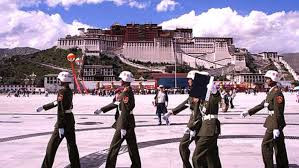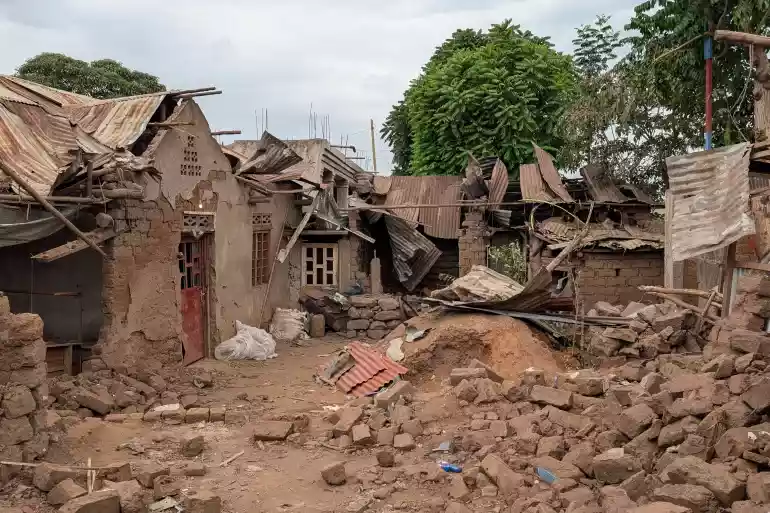
China's government has been systematically uprooting hundreds of Tibetan villages and nomads from their ancestral lands. It has been forcibly relocating them to centralized settlements under the guise of "poverty alleviation" and environmental protection.
This mass relocation campaign has accelerated dramatically since 2016. It is eroding Tibetan culture, disrupting traditional livelihoods, and leaving many relocated families impoverished and dependent on government subsidies.
Mass Systematic Relocation
According to a recent report by Human Rights Watch, over 930,000 rural Tibetans have been relocated since 2000. A staggering 76% of these relocations occurred just since 2016. The Chinese government frames these relocations as voluntary poverty reduction efforts. However, evidence suggests they are often coercive and driven by Beijing's political agenda to assimilate Tibetans and tighten control over the region.
Many of these relocations involve moving entire villages hundreds of kilometers from their original homes. Authorities refer to the relocated Tibetans as "border guardians," essentially turning them into civilian sentries along China's contested frontiers with India, Nepal, and Bhutan.
Satellite imagery shows that China has strategically placed new settlements near virtually every accessible Himalayan pass along these borders. While officially civilian in nature, these border villages provide infrastructure that could support rapid military deployments if needed.
More insidiously, they serve as a form of "demographic engineering," permanently altering the population of contested areas to strengthen China's territorial claims.
Loss of Economic Self-Sufficiency
- The brains behind Matavire’s immortalisation
- Red Cross work remembered
- All set for inaugural job fair
- Community trailblazers: Dr Guramatunhu: A hard-driving achiever yearning for better Zim
Keep Reading
But for the Tibetans themselves, these relocations often lead to economic hardships and cultural dislocation. Traditional nomadic herders are forced to sell their livestock and abandon their grasslands. Farmers are moved from their ancestral fields. In their new homes, many struggle to find work or make ends meet.
A local government document reviewed by The New York Times indicated some villagers may receive around 20,000 yuan (less than $3,000 USD) per year for relocation. A few earn extra income from border patrol work. But for many, the relocations mean a complete loss of economic self-sufficiency.
China's relocation policies appear not just to control Tibetan populations, but to fundamentally reshape Tibetan society and culture. Religious life is noticeably absent from the new settlements. There are no Buddhist monasteries or temples to be found. Instead, the villages are dominated by symbols of the Chinese state — national flags and portraits of President Xi Jinping adorn walls and light poles throughout.
This cultural erasure is no accident. The relocation program serves as propaganda, a display of Chinese strength and superiority in the region. It is social engineering aimed at assimilating Tibetans into mainstream Chinese society.
Erasing Tibetan Culture
The mass relocations are just one component of China's broader efforts to reshape Tibet. Increased surveillance, restrictions on religious practices, and Mandarin-language education policies all serve to undermine Tibetan identity and autonomy.
China's government has been systematically uprooting hundreds of Tibetan villages and nomads from their ancestral lands. It has been forcibly relocating them to centralized settlements under the guise of "poverty alleviation" and environmental protection.
This mass relocation campaign has accelerated dramatically since 2016. It is eroding Tibetan culture, disrupting traditional livelihoods, and leaving many relocated families impoverished and dependent on government subsidies.
Mass Systematic RelocationAccording to a recent report by Human Rights Watch, over 930,000 rural Tibetans have been relocated since 2000. A staggering 76% of these relocations occurred just since 2016. The Chinese government frames these relocations as voluntary poverty reduction efforts. However, evidence suggests they are often coercive and driven by Beijing's political agenda to assimilate Tibetans and tighten control over the region.
An image obtained via social media appeares to show nuns and monks being forced out of Yachen Gar, a major Tibetan Buddhist center. (From the Central Tibetan Administration official website)
Many of these relocations involve moving entire villages hundreds of kilometers from their original homes. Authorities refer to the relocated Tibetans as "border guardians," essentially turning them into civilian sentries along China's contested frontiers with India, Nepal, and Bhutan.
Satellite imagery shows that China has strategically placed new settlements near virtually every accessible Himalayan pass along these borders. While officially civilian in nature, these border villages provide infrastructure that could support rapid military deployments if needed.
More insidiously, they serve as a form of "demographic engineering," permanently altering the population of contested areas to strengthen China's territorial claims.
Loss of Economic Self-SufficiencyBut for the Tibetans themselves, these relocations often lead to economic hardships and cultural dislocation. Traditional nomadic herders are forced to sell their livestock and abandon their grasslands. Farmers are moved from their ancestral fields. In their new homes, many struggle to find work or make ends meet.
A local government document reviewed by The New York Times indicated some villagers may receive around 20,000 yuan (less than $3,000 USD) per year for relocation. A few earn extra income from border patrol work. But for many, the relocations mean a complete loss of economic self-sufficiency.
China's relocation policies appear not just to control Tibetan populations, but to fundamentally reshape Tibetan society and culture. Religious life is noticeably absent from the new settlements. There are no Buddhist monasteries or temples to be found. Instead, the villages are dominated by symbols of the Chinese state — national flags and portraits of President Xi Jinping adorn walls and light poles throughout.
This cultural erasure is no accident. The relocation program serves as propaganda, a display of Chinese strength and superiority in the region. It is social engineering aimed at assimilating Tibetans into mainstream Chinese society.
Erasing Tibetan CultureThe mass relocations are just one component of China's broader efforts to reshape Tibet. Increased surveillance, restrictions on religious practices, and Mandarin-language education policies all serve to undermine Tibetan identity and autonomy.
The forced relocations, however, are particularly devastating in their scope and impact on traditional ways of life. A Human Rights Watch report highlights how Chinese authorities use coercive tactics to overcome Tibetans' reluctance to relocate. Officials make repeated home visits, threaten with punishments, and warn that essential services will be cut off for those who refuse to move. Higher-level authorities pressure local officials to meet relocation quotas, framing the program as a non-negotiable policy for Beijing.
Even when relocations are framed as "voluntary," Tibetan families are often misled about the economic prospects of their new homes. Surveys by Chinese scholars found that many relocated Tibetans "cannot find suitable jobs to support their families" and report low satisfaction with their new circumstances.
Entire Villages RelocatedThe scale of these relocations is staggering. Beyond the 140,000 rural Tibetans moved through "whole-village relocation," another 567,000 may have been relocated through "individual household" programs since 2016. In total, Human Rights Watch estimates that various relocation and "sedentarization" programs have affected most of Tibet's 4.55 million rural inhabitants.
China's approach to ethnic minorities, particularly in Tibet, reveals a deeply manipulative strategy aimed at erasing distinct cultural identities. Under the guise of poverty alleviation and modernization, the Chinese government systematically undermines minority cultures. This is achieved through forced relocations, language policies favoring Mandarin, and strict controls on religious practices.
Destroying DiversityThese tactics are not merely about economic development or national security. They reflect a concerted effort to homogenize diverse populations into a singular state-approved Chinese identity. By uprooting communities from their ancestral lands, severing ties to traditional livelihoods, and flooding minority areas with Han Chinese settlers, Beijing seeks to dilute and eventually erase unique ethnic identities.
The government's heavy-handed approach demonstrates a fundamental disregard for the value of cultural diversity. It undermines the rights of minority populations to maintain distinct ways of life. This cultural erasure, masked as progress, is a form of soft ethnic cleansing that threatens to permanently alter the rich tapestry of ethnicities within China's borders.
International law prohibits forced evictions, making China's coercive relocation program a clear violation of human rights. The mass displacement of Tibetan communities threatens to irreparably damage Tibetan culture and identity. That way, Tibetan identity is in the hands of the Chinese party-state and is eradicated under different policy directives.
Beijing's Expansionist Nightmare Continues
The evidence paints a clear picture of a systematic campaign to reshape Tibet's demographics, consolidate state control, and erode Tibetan cultural identity.
Far from alleviating poverty, these forced relocations are creating a class of displaced impoverished Tibetans. They have been made dependent on state subsidies and cut off from their traditional livelihoods and cultural roots.
As China continues to tighten its grip on Tibet, the international community must speak out against these forced relocations and other policies that threaten Tibetan culture and autonomy. Without intervention, China's campaign of demographic engineering and cultural erasure in Tibet will only accelerate. It will potentially destroy one of the world's most unique and vibrant cultures.
"The unique Chinese style of imperialism and colonialism" as Beijing might like to call it if it succeeds, sees Tibet as its first prey and victim. However, the big, ambitious Chinese dream of expansion doesn't stop there. You can see what is happening in Southern Mongolia and Eastern Turkistan (aka the Uyghur Autonomous Region). Every neighboring people and nation of Communist China could face the same destiny unless the world is consciously watchful.











